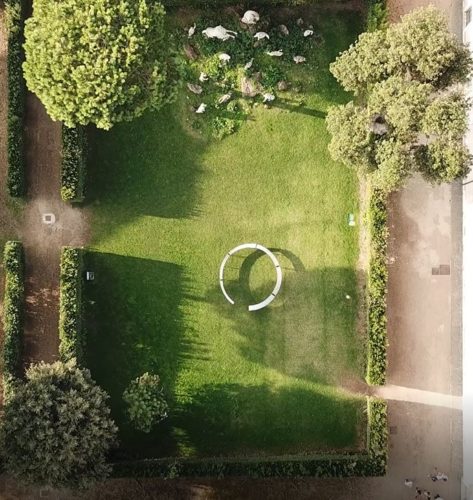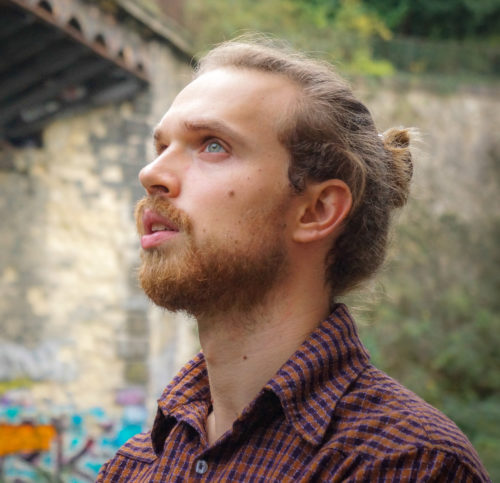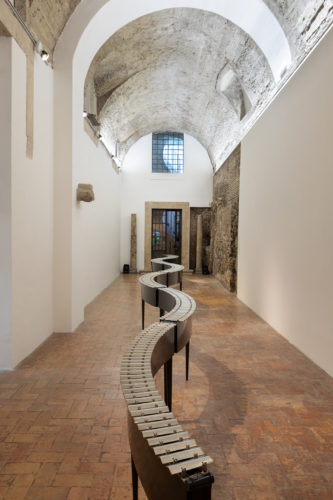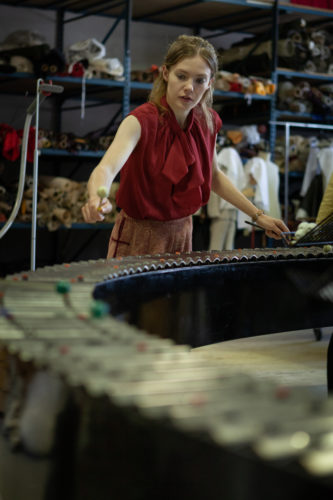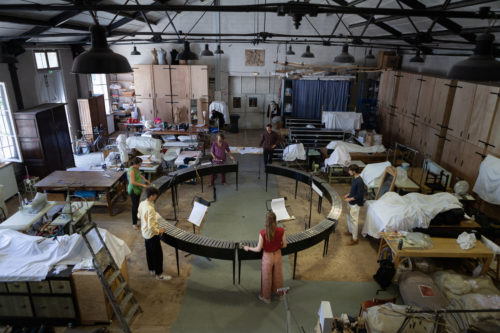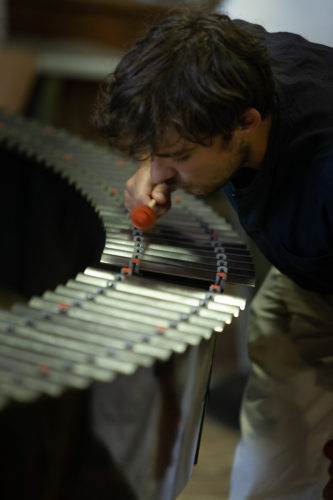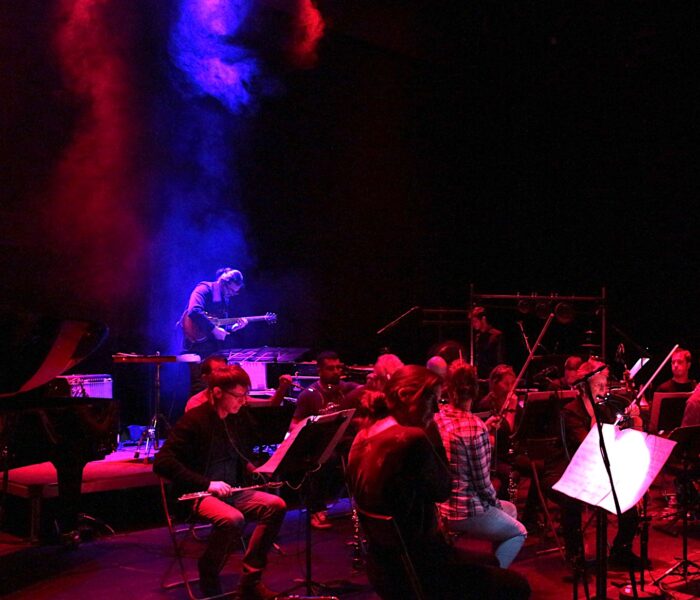Quand on demande à Bastien David, compositeur tout juste trentenaire, où il puise son inspiration, il évoque la nature, une nature dense, vivante et riche, magnifique autant qu’hostile, comme celle de l’île de la Réunion où il aime aller composer. Mais il ajoute aussitôt que les idées peuvent jaillir de toutes parts, dans les rapports quotidiens avec les choses et les échanges avec les êtres : la vie est inspirante pour le compositeur à l’affût…
L’année 2022, le 8 mai très exactement, date de l’événement programmé à l’Auditorium de la Maison de la Radio, sera pour lui l’aboutissement d’un projet mûri durant quelques huit années : un concert-spectacle autour du « Métallophone », instrument qu’il a rêvé et réalisé de ses mains et que six percussionnistes mettront en résonance. Il revient pour nous sur la genèse de cette aventure aussi belle que fabuleuse, qui s’inscrit dans la démarche singulière de notre compositeur-chercheur.
J’aimerais, Bastien, que tu remontes à la source du projet « Métallophone ». Quel a été ton désir premier ?
Il est difficile de parler d’un désir premier car les envies ont été plurielles : en premier lieu, peut-être, celle de vivre une expérience sonore inouïe qui m’anime depuis longtemps et qui va au-delà même de l’instrument ; dans la mesure où elle implique le rapport au partage, avec les musiciens qui vont jouer cet instrument acoustique et s’approprier ses qualités résonnantes ; avec le-les publics qui vont découvrir l’instrument et vivre cette expérience immersive dans des conditions d’écoute renouvelées où les yeux comme les oreilles seront sollicités. Je précise que le projet «Métallophone» est associé à la création de la compagnie « Les insectes », six percussionnistes réunis autour de l’instrument : Adelaïde Ferrière, Aurélien Gignoux, Elisa Humanes, Maxime Echardour, Morgane Laplace-Mermoud et Ya-Hui Liang.
La construction de cet instrument a pris plusieurs années. Á quelle époque s’ébauche-t-elle ?
Elle est liée à mon premier voyage en Birmanie en 2012 et à la rencontre avec les lames d’acier qui constituent le matériau de base de cet instrument de percussion microtonal. Je me suis très vite posé la question de l’accordage de ces lames, fantasmant sur l’échelle au 1/12ème de ton, intéressante car elle croise celle en quart et tiers de ton. Je suis retourné plusieurs fois en Birmanie, réfléchissant sur la taille à donner à l’instrument, le nombre de lames et la jouabilité du métallophone. La forme globale (116 lames sur 12 mètres de long) a résulté de tous ces questionnements. L’accordage des lames de métal s’est effectué de manière artisanale, durant deux mois d’un travail intense avec un facteur de vibraphone traditionnel qui ne parlait pas l’anglais. J’ai habité sur les lieux mêmes de l’atelier, un ancien monastère qui avait la qualité d’offrir un sol plat pour poser les lames sur douze mètres de long.
C’est la première étape de l’élaboration qui allait se poursuivre et s’achever sur d’autres terres…
En effet ; le coffre en bois laqué du métallophone a été l’ouvrage d’un artisan français tandis que les chevalets ont été réalisés en Italie durant mon séjour à la Villa Medicis. Je pensais, à cette époque, pouvoir débuter l’écriture mais la finalisation a été plus longue que prévue. J’étais fier cependant que l’instrument terminé soit présenté en tant qu’objet physique et plastique dans l’exposition consacrée aux pensionnaires plasticiens de la Villa Médicis.
Selon le contexte où il est installé, l’instrument a cette capacité de se métamorphoser…
Placé au centre de l’espace, dans la grande galerie de la « Villa », il prend la forme d’une colonne vertébrale voire d’une onde sonore. L’idée est de distribuer les claviers selon la géométrie des lieux et de les faire dialoguer avec l’espace. Photographié dans les jardins de la « Villa », le Métallophone adopte la forme circulaire tandis qu’il dessine une arche dans la salle du Musée Beaubourg où il voisine une sculpture de Calder. J’aimerais que l’objet ainsi exposé aux yeux du public se dote d’un imaginaire physique et amène le spectateur à un voyage mental. L’instrument mute en fonction des lieux qui l’accueillent, lieux qui ne sont pas seulement destinés à la musique, qui peuvent associer d’autres formes d’art ou s’inscrire dans un décor naturel comme une forêt, une grotte ou un jardin. Plus l’instrument va voyager, plus il va rencontrer de publics différents. C’est l’enjeu de ce projet nomade : rassembler des gens différents autour d’un même objet. Le Métallophone est installé aujourd’hui à Royaumont où nous serons en résidence durant le mois de février 2022 pour travailler la pièce qui m’a été commandée par Radio France ; c’est un lieu qui se prête à l’instrument tout comme l’instrument répond au lieu, par la résonance qu’il offre, son rapport au jardin, à l’histoire et à la création. J’aimerais évidemment que les pupitres disparaissent, que les musiciens jouent par cœur pour créer une cohésion entre leurs gestes respectifs et la physionomie de l’instrument.
Ce n’est pas le premier instrument que tu construis ? Peux-tu évoquer tes autres réalisations ?
Dans le cadre de mes études au Conservatoire supérieur de Paris, J’ai fabriqué un instrument d’action mécanique avec des bols tibétains que j’ai appelé « mes petites machines » ; je ne sais pas si je vais continuer dans cette direction mais le fait de construire des choses en associant divers éléments est une pratique qui est constante chez moi. Elle m’anime une fois encore dans le projet de CD que je mène avec l’accordéoniste Vincent Gailly où j’introduis des microphones dans le corps résonnant des instruments pour en modifier la sonorité. Il est possible que cette nouvelle recherche où les microphones deviennent des instruments à part entière puisse s’étoffer grâce aux ressources de l’Ircam qui m’a contacté.
Helmut Lachenmann dit que « composer c’est construire son instrument ». Qu’est-ce que signifie pour toi « construire un instrument »?
C’est pour moi invoquer un imaginaire, un rapport immédiat au sonore qui entre en contact avec nous-mêmes pour provoquer une nouvelle sensation. C’est aussi tout ce qui se situe en amont de la construction, les échanges humains que cela va provoquer, la jouabilité, le rapport au corps, au regard, à l’écoute, à l’espace, le rapport à la notation, à la composition. Construire un instrument, c’est se poser une foule de questions et essayer d’y répondre de manière la plus simple en questionnant l’instrument lui-même. Le but n’est pas esthétique, c’est un ressenti que j’ai. Je mentionnerai aussi le rapport au solo qu’il induit.
Je pense à Riff, mon premier solo pour violoncelle que j’ai écrit pour Marie Ythier et qui m’a fait prendre conscience que plus le rapport à l’instrument est simple plus on va pouvoir pousser la complexité. Il s’agit d’essayer de comprendre ce que nous raconte à nous l’instrument, d’être à son écoute et à celle de l’instrumentiste pour lui écrire ce que l’on a le plus envie de lui offrir. J’ai renouvelé l’expérience avec mon solo d’accordéon à l’adresse de Vincent Gailly, de piano pour Dimitri Vassilakis et je termine un solo de violon pour Renaud Capuçon. Mon prochain solo sera pour le Métallophone !
Tu as en effet une commande de Radio France pour mai 2022. Le Métallophone se tiendra dans l’auditorium sous sa forme circulaire, en lien avec la conformité de la salle. Plus qu’un concert, c’est un événement qui se profile !
Ce sera sans nul doute un moment très émouvant pour moi ; j’ai débuté le projet à 22 ans et j’en aurai 31 ! La pièce fera une quarantaine de minutes et je souhaite que l’écoute soit alimentée d’une discussion autour du projet et qu’il s’établisse un lien entre nos oreilles et nos yeux : à travers le mouvement de la baguette sur la lame et les déplacements des percussionnistes qui deviennent presque des danseurs ; avec les photos et le rendu plastique de l’instrument sur les panneaux qui borderont le plateau ; quant à la musique que j’imagine la plus délicate possible, avec des sonorités aquatiques parfois un peu électroniques, j’aimerais qu’elle nous fasse vivre un moment particulier en immersion, entretenu par la résonance hypnotique des lames d’acier .
Tu as débuté l’écriture sur partition. Je suppose que la question de la notation a été une étape importante pour toi.
Le fait d’avoir fixé la notation me donne des ailes. Quand on a l’instrument sans la notation c’est comme avoir des idées sans les mots pour les exprimer. Je suis très satisfait du résultat concernant l’écriture de la microtonalité et la lisibilité des signes, chose essentielle pour moi et pour les musiciens ; même si cette notation peut encore évoluer. Je n’ai pour l’instant que trois minutes de musique et déjà vingt-sept pages d’écriture. Le manuscrit risque d’être impressionnant ! J’aimerais aussi le présenter au public le 8 mai, comme un objet graphique que je souhaite inclure à ce concert-exposition.
L’œuvre a déjà un titre que tu dévoiles dores et déjà sur ton site…
Oui, Les Métamorphoses est le titre de ce moment musical ! Titre qui s’est imposé à moi par le sujet dont traite la pièce. Il fait référence aux différentes mutations que connaissent entre autres les insectes, nom de la compagnie du Métallophone.
L’envergure de la manifestation et la taille du Métallophone ne risquent-elles pas de freiner l’élan des programmateurs ?
Je rappelle d’abord que l’instrument a cette capacité de prendre différentes formes, de s’adapter en quelque sorte à l’espace qui l’accueille. Je suis assez confiant quant à la volonté des programmateurs de faire évoluer la notion du concert. On vit une période où il est intéressant de repenser ses modalités dans une cohérence avec le monde dans lequel on vit aujourd’hui ; mon désir à travers « le projet Métallophone » est de changer le paradigme de la création, d’écrire une pièce qui permette de rencontrer des publics différents, qui soit portée voire retravaillée selon les lieux où elle sera jouée, qui vive et s’adapte aux espaces où elle sonne. Il était important de créer une compagnie de musiciens qui se connaissent, puissent répéter ensemble et acquièrent une connaissance en profondeur de l’instrument. L’association va d’ailleurs passer de six à douze percussionnistes, de manière à établir un roulement au sein du groupe en fonction des disponibilités de chacun.
Le Métallophone est-il un instrument tout-terrain ?
On l’entendra résonner en intérieur comme à l’extérieur ; mais cela reste un instrument de musique avec sa sensibilité et sa fragilité, à la chaleur, à l’humidité… même s’il a déjà résisté aux ardeurs du soleil romain !
Le Métallophone et ses six percussionnistes seront révélés au public dès l’automne prochain…
L’instrument investit l’église du Musée des Arts et Métiers dans le cadre de la Nuit blanche le 2 octobre prochain et entrera en dialogue avec le célèbre Pendule de Foucault. L’acoustique des lieux est magnifique et donnera à entendre un extrait de la partition en cours, le mieux adapté au contexte du pendule qui se balancera au milieu de l’instrument.
Propos recueillis par Michèle Tosi



)
